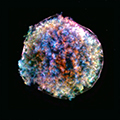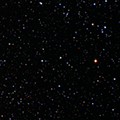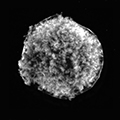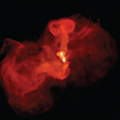CXC Home | Search | Help | Image Use Policy | Latest Images | Privacy | Accessibility | Glossary | Q&A
Download this video (MP4)
Westerlund 2 Sonification
Credit: NASA/CXC/SAO/K.Arcand, SYSTEM Sounds (M. Russo, A. Santaguida)
[Runtime: 01:04]
 Audio Only Versions
Audio Only Versions
This is a cluster of young stars — about one to two million years old — located about 20,000 light years from Earth. In its visual image form, data from Hubble (green and blue) reveals thick clouds where stars are forming, while X-rays seen from Chandra (purple) penetrate through that haze. In the sonified version of this data, sounds sweep from left to right across the field of view with brighter light producing louder sound. The pitch of the notes indicates the vertical position of the sources in the image with the higher pitches towards the top of the image. The Hubble data is played by strings, either plucked for individual stars or bowed for diffuse clouds. Chandra's X-ray data is represented by bells, and the more diffuse X-ray light is played by more sustained tones.
Credit: NASA/CXC/SAO/K.Arcand, SYSTEM Sounds (M. Russo, A. Santaguida)
[Runtime: 01:04]
 Audio Only Versions
Audio Only Versions
This is a cluster of young stars — about one to two million years old — located about 20,000 light years from Earth. In its visual image form, data from Hubble (green and blue) reveals thick clouds where stars are forming, while X-rays seen from Chandra (purple) penetrate through that haze. In the sonified version of this data, sounds sweep from left to right across the field of view with brighter light producing louder sound. The pitch of the notes indicates the vertical position of the sources in the image with the higher pitches towards the top of the image. The Hubble data is played by strings, either plucked for individual stars or bowed for diffuse clouds. Chandra's X-ray data is represented by bells, and the more diffuse X-ray light is played by more sustained tones.
Download this video (MP4)
Tycho's Supernova Remnant Sonification
Credit: NASA/CXC/SAO/K.Arcand, SYSTEM Sounds (M. Russo, A. Santaguida)
[Runtime: 00:59]
 Audio Only Versions
Audio Only Versions
Beginning in the center, the sonification of the Tycho supernova remnant expands outward in a circle. The image contains X-ray data from Chandra where the various colors represent small bands of frequency that are associated with different elements that are moving both toward and away from Earth. For example, red shows iron, green is silicon, and blue represents sulfur. The sonification aligns with those colors as the redder light produces the lowest notes and blue and violet create the higher-pitched notes. Color varies over the remnant, but the lowest and highest notes (red and blue) dominate near the center and are joined by other colors (mid-range notes) towards the edge of the remnant. White corresponds to the full range of frequencies of light observable by Chandra, which is strongest toward the edge of the remnant. This light is converted to sound in a more direct way as well, by interpreting frequencies of light as frequencies of sound and then shifting them lower by 50 octaves so that they fall within the human hearing range. The different proportions of iron, silicon, and sulfur across the remnant can be heard in the changing amounts of the low-, mid-, and high-frequency peaks in the sound. The field of stars in the image as observed by Hubble is played as notes on a harp with the pitch determined by their color.
Credit: NASA/CXC/SAO/K.Arcand, SYSTEM Sounds (M. Russo, A. Santaguida)
[Runtime: 00:59]
 Audio Only Versions
Audio Only Versions
Beginning in the center, the sonification of the Tycho supernova remnant expands outward in a circle. The image contains X-ray data from Chandra where the various colors represent small bands of frequency that are associated with different elements that are moving both toward and away from Earth. For example, red shows iron, green is silicon, and blue represents sulfur. The sonification aligns with those colors as the redder light produces the lowest notes and blue and violet create the higher-pitched notes. Color varies over the remnant, but the lowest and highest notes (red and blue) dominate near the center and are joined by other colors (mid-range notes) towards the edge of the remnant. White corresponds to the full range of frequencies of light observable by Chandra, which is strongest toward the edge of the remnant. This light is converted to sound in a more direct way as well, by interpreting frequencies of light as frequencies of sound and then shifting them lower by 50 octaves so that they fall within the human hearing range. The different proportions of iron, silicon, and sulfur across the remnant can be heard in the changing amounts of the low-, mid-, and high-frequency peaks in the sound. The field of stars in the image as observed by Hubble is played as notes on a harp with the pitch determined by their color.
Download this video (MP4)
M87 Sonification
Credit: NASA/CXC/SAO/K.Arcand, SYSTEM Sounds (M. Russo, A. Santaguida)
[Runtime: 00:32]
 Audio Only Versions
Audio Only Versions
The giant black hole in Messier 87 (M87 for short) and its surroundings have been studied for many years and by a range of telescopes including Chandra (blue) and the Very Large Array (red and orange). This data shows that the black hole in M87 is sending out massive jets of energetic particles that interact with vast clouds of hot gas that surround it. To translate the X-rays and radio waves into sound, the image is scanned beginning at the 3 o'clock position and sweeping clockwise like a radar. Light farther from the center is heard as higher pitched while brighter light is louder. The radio data are lower pitched than the X-rays, corresponding to their frequency ranges in the electromagnetic spectrum. The point-like sources in X-ray light, most of which represent stars in orbit around a black hole or neutron star, are played as short, plucked sounds.
Credit: NASA/CXC/SAO/K.Arcand, SYSTEM Sounds (M. Russo, A. Santaguida)
[Runtime: 00:32]
 Audio Only Versions
Audio Only Versions
The giant black hole in Messier 87 (M87 for short) and its surroundings have been studied for many years and by a range of telescopes including Chandra (blue) and the Very Large Array (red and orange). This data shows that the black hole in M87 is sending out massive jets of energetic particles that interact with vast clouds of hot gas that surround it. To translate the X-rays and radio waves into sound, the image is scanned beginning at the 3 o'clock position and sweeping clockwise like a radar. Light farther from the center is heard as higher pitched while brighter light is louder. The radio data are lower pitched than the X-rays, corresponding to their frequency ranges in the electromagnetic spectrum. The point-like sources in X-ray light, most of which represent stars in orbit around a black hole or neutron star, are played as short, plucked sounds.
Download this video (MP4)
A Tour of Jingle, Pluck, and Hum: Sounds from Space
(Credit: NASA/CXC/A. Hobart)
[Runtime: 03:59]
With closed-captions (at YouTube)
Space is mostly quiet. Data collected by telescopes are most often turned into silent charts, plots, and images. A "sonification" project led by NASA's Chandra X-ray Observatory and the Universe of Learning transforms otherwise inaudible data from some of the world's most powerful telescopes into sound. This effort makes it possible to experience data from cosmic sources with a different sense: hearing.
The latest installment of this sonification project features a region where stars are forming (Westerlund 2), the debris field left behind by an exploded star (Tycho's supernova remnant), and the region around arguably the most famous black hole (Messier 87*). Each sonification has its own technique to translate the astronomical data into sounds that humans can hear.
Westerlund 2 is a cluster of young stars — about one to two million years old — located about 20,000 light years from Earth. In the sonified version of these data from Chandra and Hubble, the pitch of the notes indicates the vertical position of the sources in the image with the higher pitches towards the top of the image. Meanwhile, the volume corresponds to the brightness of each source. The Hubble data are played by strings, where the stars are plucked strings and the clouds are strummed notes. Chandra's X-ray data are represented by bells and the more diffuse X-ray light are played by more sustained tones.
Beginning in the center, the sonification of the Tycho supernova remnant expands outward in a circle. The image contains X-ray data from Chandra where the various colors represent small bands of frequency that are associated with different elements that are moving both toward and away from Earth. For example, red shows iron, green is silicon, and blue represents sulfur. The sonification aligns with those colors as the redder light produces the lowest notes and blue and violet create the higher pitched notes. White corresponds to the full range of frequencies of light observable by Chandra, which is strongest toward the edge of the remnant.
The giant black hole in Messier 87 (M87 for short) and its surroundings have been studied for many years and by a range of telescopes including Chandra and the Very Large Array. These data show that the black hole in M87 is sending out massive jets of energetic particles that interact with vast clouds of hot gas that surround it. To translate the X-rays and radio waves into sound, the image is scanned beginning at the 3 o'clock position and sweeping to the right like a radar. The brighter data, the louder and higher pitched the sounds are. The radio data are lower pitched than the X-rays. The point-like sources in X-ray light, most of which represent stars in orbit around a black hole or neutron star, are played a short, plucked sounds.
Listen for more from the sonification project in the future.
(Credit: NASA/CXC/A. Hobart)
[Runtime: 03:59]
With closed-captions (at YouTube)
Space is mostly quiet. Data collected by telescopes are most often turned into silent charts, plots, and images. A "sonification" project led by NASA's Chandra X-ray Observatory and the Universe of Learning transforms otherwise inaudible data from some of the world's most powerful telescopes into sound. This effort makes it possible to experience data from cosmic sources with a different sense: hearing.
The latest installment of this sonification project features a region where stars are forming (Westerlund 2), the debris field left behind by an exploded star (Tycho's supernova remnant), and the region around arguably the most famous black hole (Messier 87*). Each sonification has its own technique to translate the astronomical data into sounds that humans can hear.
Westerlund 2 is a cluster of young stars — about one to two million years old — located about 20,000 light years from Earth. In the sonified version of these data from Chandra and Hubble, the pitch of the notes indicates the vertical position of the sources in the image with the higher pitches towards the top of the image. Meanwhile, the volume corresponds to the brightness of each source. The Hubble data are played by strings, where the stars are plucked strings and the clouds are strummed notes. Chandra's X-ray data are represented by bells and the more diffuse X-ray light are played by more sustained tones.
Beginning in the center, the sonification of the Tycho supernova remnant expands outward in a circle. The image contains X-ray data from Chandra where the various colors represent small bands of frequency that are associated with different elements that are moving both toward and away from Earth. For example, red shows iron, green is silicon, and blue represents sulfur. The sonification aligns with those colors as the redder light produces the lowest notes and blue and violet create the higher pitched notes. White corresponds to the full range of frequencies of light observable by Chandra, which is strongest toward the edge of the remnant.
The giant black hole in Messier 87 (M87 for short) and its surroundings have been studied for many years and by a range of telescopes including Chandra and the Very Large Array. These data show that the black hole in M87 is sending out massive jets of energetic particles that interact with vast clouds of hot gas that surround it. To translate the X-rays and radio waves into sound, the image is scanned beginning at the 3 o'clock position and sweeping to the right like a radar. The brighter data, the louder and higher pitched the sounds are. The radio data are lower pitched than the X-rays. The point-like sources in X-ray light, most of which represent stars in orbit around a black hole or neutron star, are played a short, plucked sounds.
Listen for more from the sonification project in the future.
Download this video (MP4)
A Quick Look at Jingle, Pluck, and Hum: Sounds from Space
(Credit: NASA/CXC/A. Hobart)
[Runtime: 00:45]
Three new objects are being released in NASA's sonification project.
Sonification is a process that turns data into sounds.
This project allows people to experience data from space by hearing them.
"Hear" this star-forming region, supernova remnant, and black hole for the first time.
(Credit: NASA/CXC/A. Hobart)
[Runtime: 00:45]
Three new objects are being released in NASA's sonification project.
Sonification is a process that turns data into sounds.
This project allows people to experience data from space by hearing them.
"Hear" this star-forming region, supernova remnant, and black hole for the first time.
Audio Only Versions (Downloads)
| MP3 | OGG | M4R | |
|---|---|---|---|
| MP3 | OGG | M4R | |
| All Wavelengths | .mp3 | .ogg | .m4r |
| X-ray | .mp3 | .ogg | .m4r |
| Optical | .mp3 | .ogg | .m4r |
| MP3 | OGG | M4R | |
|---|---|---|---|
| All Wavelengths | .mp3 | .ogg | .m4r |
| X-ray | .mp3 | .ogg | .m4r |
| Optical | .mp3 | .ogg | .m4r |
| Spectra | .mp3 | .ogg | .m4r |
| MP3 | OGG | M4R | |
|---|---|---|---|
| All Wavelengths | .mp3 | .ogg | .m4r |
| X-ray Only | .mp3 | .ogg | .m4r |
| Radio Only | .mp3 | .ogg | .m4r |
Return to Jingle, Pluck, and Hum: Sounds from Space (Spetember 16, 2021)









